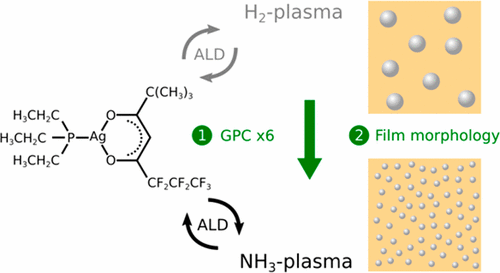当前位置:
X-MOL 学术
›
Chem. Mater.
›
论文详情
Our official English website, www.x-mol.net, welcomes your
feedback! (Note: you will need to create a separate account there.)
Plasma-Enhanced Atomic Layer Deposition of Silver Using Ag(fod)(PEt3) and NH3-Plasma
Chemistry of Materials ( IF 7.2 ) Pub Date : 2017-08-18 00:00:00 , DOI: 10.1021/acs.chemmater.7b00690 Matthias M. Minjauw 1 , Eduardo Solano 1 , Sreeprasanth Pulinthanathu Sree 2 , Ramesh Asapu 3 , Michiel Van Daele 1 , Ranjith K. Ramachandran 1 , Gino Heremans 2 , Sammy W. Verbruggen 3 , Silvia Lenaerts 3 , Johan A. Martens 2 , Christophe Detavernier 1 , Jolien Dendooven 1
Chemistry of Materials ( IF 7.2 ) Pub Date : 2017-08-18 00:00:00 , DOI: 10.1021/acs.chemmater.7b00690 Matthias M. Minjauw 1 , Eduardo Solano 1 , Sreeprasanth Pulinthanathu Sree 2 , Ramesh Asapu 3 , Michiel Van Daele 1 , Ranjith K. Ramachandran 1 , Gino Heremans 2 , Sammy W. Verbruggen 3 , Silvia Lenaerts 3 , Johan A. Martens 2 , Christophe Detavernier 1 , Jolien Dendooven 1
Affiliation

|
A plasma-enhanced atomic layer deposition (ALD) process using the Ag(fod)(PEt3) precursor [(triethylphosphine)(6,6,7,7,8,8,8-heptafluoro-2,2-dimethyl-3,5-octanedionate)silver(I)] in combination with NH3-plasma is reported. The steady growth rate of the reported process (0.24 ± 0.03 nm/cycle) was found to be 6 times larger than that of the previously reported Ag ALD process based on the same precursor in combination with H2-plasma (0.04 ± 0.02 nm/cycle). The ALD characteristics of the H2-plasma and NH3-plasma processes were verified. The deposited Ag films were polycrystalline face-centered cubic Ag for both processes. The film morphology was investigated by ex situ scanning electron microscopy and grazing-incidence small-angle X-ray scattering, and it was found that films grown with the NH3-plasma process exhibit a much higher particle areal density and smaller particle sizes on oxide substrates compared to those deposited using the H2-plasma process. This control over morphology of the deposited Ag is important for applications in catalysis and plasmonics. While films grown with the H2-plasma process had oxygen impurities (∼9 atom %) in the bulk, the main impurity for the NH3-plasma process was nitrogen (∼7 atom %). In situ Fourier transform infrared spectroscopy experiments suggest that these nitrogen impurities are derived from NHx surface groups generated during the NH3-plasma, which interact with the precursor molecules during the precursor pulse. We propose that the reaction of these surface groups with the precursor leads to additional deposition of Ag atoms during the precursor pulse compared to the H2-plasma process, which explains the enhanced growth rate of the NH3-plasma process.
中文翻译:

Ag(fod)(PEt 3)和NH 3-等离子体对银的等离子体增强原子层沉积
使用Ag(fod)(PEt 3)前体[(三乙基膦)(6,6,7,7,8,8,8,8-七氟-2,2-二甲基-3)的等离子体增强原子层沉积(ALD)工艺报道了与5-NH 3-血浆组合的[,5-辛二酸酯)银(I)] 。发现报告的过程的稳定增长率(0.24±0.03 nm /周期)比以前报告的基于相同前体与H 2等离子体结合的Ag ALD过程的稳定增长率(0.04±0.02 nm /周期)大6倍。循环)。H 2-等离子体和NH 3的ALD特征-等离子体过程得到了验证。对于两种工艺,沉积的Ag膜均为多晶面心立方Ag。通过异位扫描电子显微镜和掠入射小角X射线散射研究了膜的形态,发现用NH 3等离子体工艺生长的膜在氧化物上具有更高的颗粒面密度和更小的粒径。与使用H 2-等离子体工艺沉积的衬底相比。对于沉积的Ag的形态的这种控制对于催化和等离子体激元的应用是重要的。用H 2等离子体工艺生长的薄膜在整体中具有氧杂质(〜9原子%),而NH 3的主要杂质-等离子体过程是氮(〜7原子%)。原位傅里叶变换红外光谱实验表明,这些氮杂质源自在NH 3-等离子体过程中产生的NH x表面基团,这些表面基团在前驱物脉冲期间与前驱物分子相互作用。我们提出,与H 2-等离子体过程相比,这些表面基团与前体的反应导致在前驱脉冲期间Ag原子的额外沉积,这解释了NH 3-等离子体过程的增加的生长速率。
更新日期:2017-08-19
中文翻译:

Ag(fod)(PEt 3)和NH 3-等离子体对银的等离子体增强原子层沉积
使用Ag(fod)(PEt 3)前体[(三乙基膦)(6,6,7,7,8,8,8,8-七氟-2,2-二甲基-3)的等离子体增强原子层沉积(ALD)工艺报道了与5-NH 3-血浆组合的[,5-辛二酸酯)银(I)] 。发现报告的过程的稳定增长率(0.24±0.03 nm /周期)比以前报告的基于相同前体与H 2等离子体结合的Ag ALD过程的稳定增长率(0.04±0.02 nm /周期)大6倍。循环)。H 2-等离子体和NH 3的ALD特征-等离子体过程得到了验证。对于两种工艺,沉积的Ag膜均为多晶面心立方Ag。通过异位扫描电子显微镜和掠入射小角X射线散射研究了膜的形态,发现用NH 3等离子体工艺生长的膜在氧化物上具有更高的颗粒面密度和更小的粒径。与使用H 2-等离子体工艺沉积的衬底相比。对于沉积的Ag的形态的这种控制对于催化和等离子体激元的应用是重要的。用H 2等离子体工艺生长的薄膜在整体中具有氧杂质(〜9原子%),而NH 3的主要杂质-等离子体过程是氮(〜7原子%)。原位傅里叶变换红外光谱实验表明,这些氮杂质源自在NH 3-等离子体过程中产生的NH x表面基团,这些表面基团在前驱物脉冲期间与前驱物分子相互作用。我们提出,与H 2-等离子体过程相比,这些表面基团与前体的反应导致在前驱脉冲期间Ag原子的额外沉积,这解释了NH 3-等离子体过程的增加的生长速率。

































 京公网安备 11010802027423号
京公网安备 11010802027423号